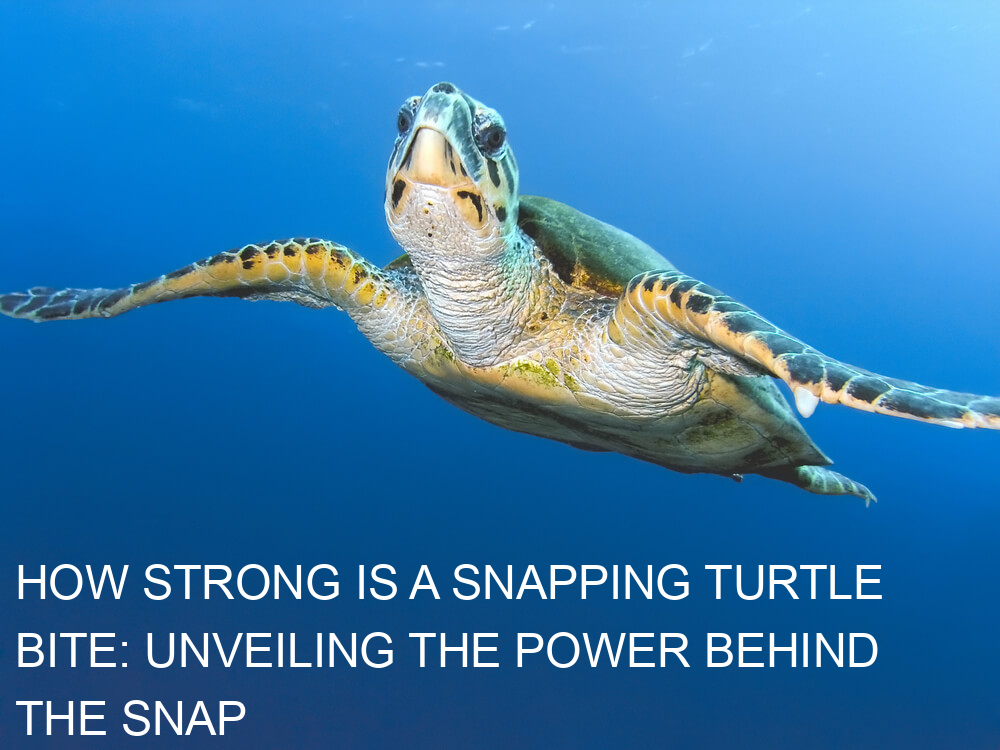Snapping turtles are often feared and admired for their powerful bites. As one of the largest freshwater turtles in the world, the curiosity surrounding their bite strength is natural.
In this article, we will explore how strong is a Snapping turtle bite, turtle’s jaw anatomy, and the force behind their bite and compare their bite strength to various other animals.
These incredible creatures are equipped with a strong, sharp beak that allows them to deliver swift and powerful bites. Their aggressive behavior is often triggered by their natural instinct to defend themselves or seize their prey.
A thorough understanding of snapping turtles’ bite force will not only provide insights into their fascinating lives but will also help us better assess the potential dangers associated with interacting with these animals in the wild.
Key Takeaways
- Snapping turtles possess a strong, sharp beak that delivers powerful bites
- Their aggressive behavior is often triggered by their natural instinct to defend themselves or seize prey
- Understanding their bite force helps assess potential dangers associated with interacting with them in the wild
How Strong Is A Snapping Turtle Bite?
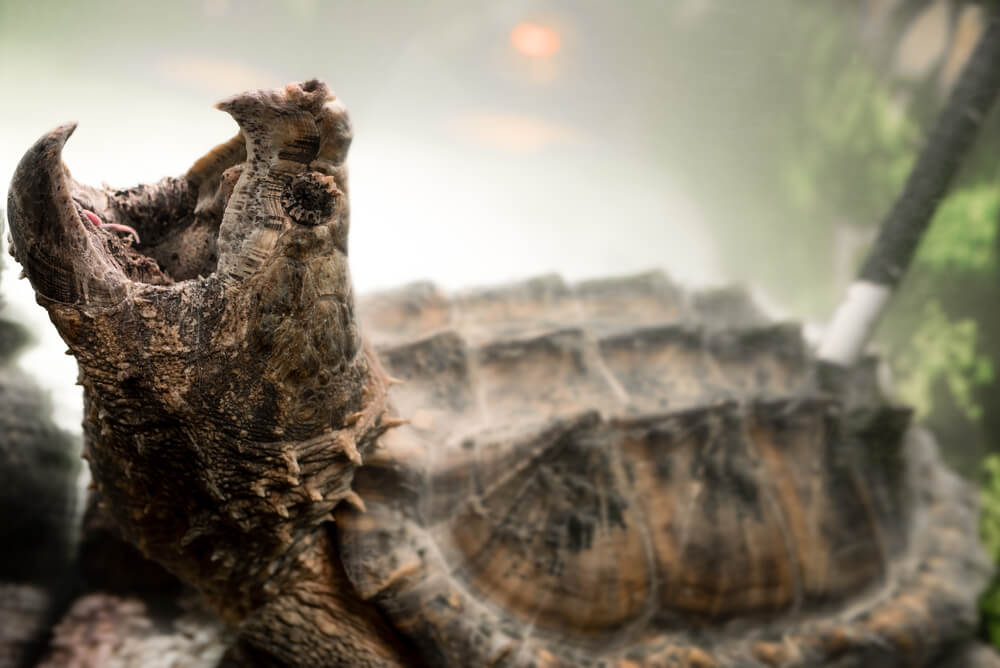
As a turtle enthusiast, I find snapping turtles particularly fascinating. They belong to the Chelydridae family and consist of two distinct species: the common snapping turtle (Chelydra serpentina) and the alligator snapping turtle (Macrochelys temminckii).
Both species are found across North America, with each species occupying their own preferred natural habitat.
The common snapping turtle, Chelydra serpentina, is more widespread and can be found in various habitats ranging from swamps to ponds and rivers. This species has three subspecies that exhibit slight variations in size, color, and physical features.
The alligator snapping turtle, on the other hand, is native to the southeastern United States. Commonly found in river systems and wetlands, this species is the largest freshwater turtle in North America.
Snapping turtles have developed impressive strength in their jaws and neck muscles, which allows them to capture and consume a variety of prey.
This strength is an integral part of their survival strategy, as these turtles have relatively small plastrons (the lower part of a turtle’s shell) compared to other turtle species.
As a result, they rely on offensive tactics instead of defense when faced with threats.
In terms of diet, both snapping turtle species are opportunistic feeders. They consume a wide variety of invertebrates, fish, and even smaller turtles.
Their powerful jaws and sharp beaks enable them to tear through their prey with ease.
Essential to their behavior and hunting tactics is their sedentary nature. Snapping turtles will often lie in wait at the bottom of their habitat, camouflaged by the murky water and debris, ready to ambush any unsuspecting prey that passes by.
This stealthy approach relies on their keen sense of smell and incredible patience.
In summary, snapping turtles are truly unique creatures, perfectly adapted to their environment and showcasing incredible strength.
As I learn more about their biology and behavior, I continue to be amazed by their adaptability and tenacity, which have allowed these species to persist in their natural habitats throughout North America.
Snapping Turtle Anatomy
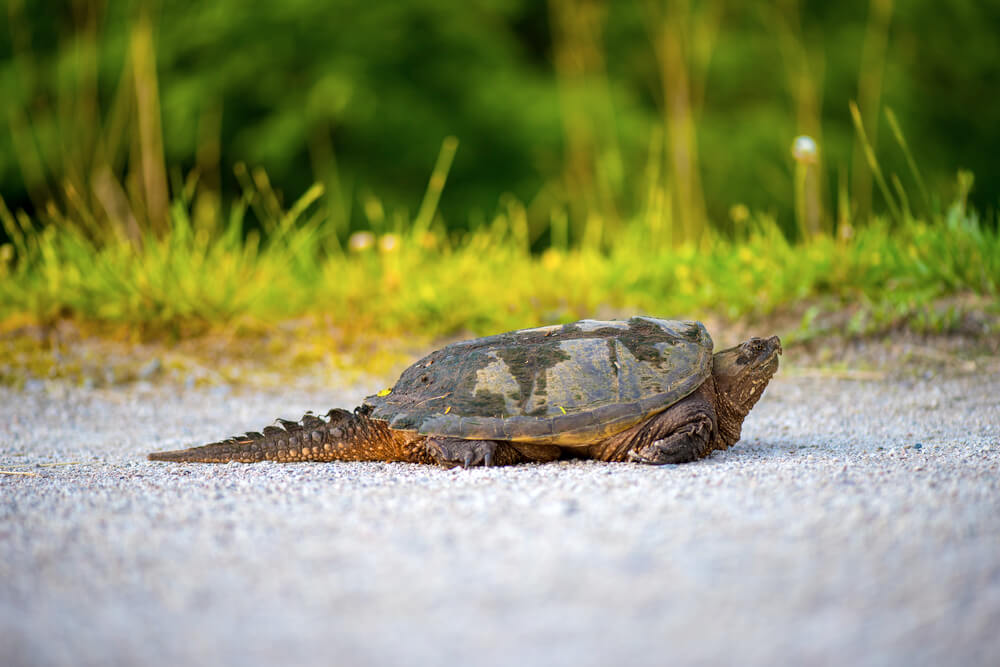
As a snapping turtle enthusiast, I can tell you that their impressive anatomy plays a significant role in their powerful bite. The most critical components of a snapping turtle’s anatomy are their jaws, sharp beak, and strong muscles.
I’ve observed that snapping turtles have a unique jaw structure compared to other aquatic animals. They possess a sturdy set of jaws with a hooked, sharp beak at the front.
This beak is made for cutting, tearing, and crushing prey, which makes their bites effective at subduing even the most robust animals.
In addition to the jaws and beak, I find the muscles supporting the turtle’s jaw to be incredibly strong. These muscles contribute to the overall force of the bite, allowing the snapping turtle to exert immense pressure.
Moreover, their neck muscles are robust as well, providing them the ability to extend their heads rapidly to snap at predators or prey.
The snapping turtle’s shell is another essential part of its anatomy.
Although it may not seem directly related to their bite, I have found that the solid shell provides protection and support to the turtle’s internal structures, allowing it to focus on capturing prey and defending itself without fear of injury.
The claws on their limbs also ensure a steady grip on the ground or prey when needed.
From my observations, I believe that the combination of a snapping turtle’s strong jaws, sharp beak, and powerful muscles is what contributes to their reputation as fierce predators in the animal kingdom.
The additional support from their shell and claws makes them even more formidable among aquatic animals.
The Aggressive Behavior of Snapping Turtles
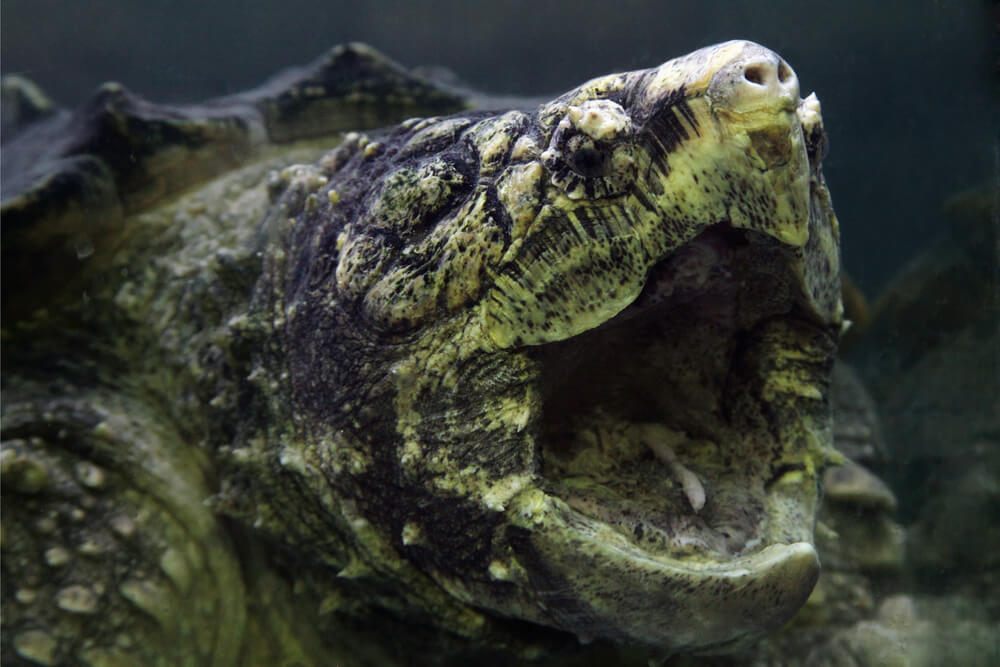
As I’ve observed, snapping turtles exhibit aggressive behavior, particularly when they encounter wild animals or when they feel threatened.
Their primary defensive tactic is to attack using their incredibly powerful jaws. Personally, I find it essential to treat these creatures with caution and respect their space in order to avoid any possible confrontations.
During my experiences with snapping turtles, I’ve learned that they tend to be quite aggressive on land as opposed to being in the water. In their aquatic environment, they feel more secure and are less likely to attack unless provoked.
On land, however, they have limited mobility, which makes them feel vulnerable and more prone to strike out defensively.
Another factor that contributes to snapping turtles’ aggressive nature is their poor eyesight. Because they cannot see very well, they may perceive movements and objects as threats, reacting with hostility.
It’s critical to remember that even though these turtles might appear to be aggressive, they’re just trying to protect themselves.
Snapping turtles can display aggressive behavior in certain situations, especially when feeling threatened or confronted by wild animals. It’s vital to approach them with caution, giving them ample space to avoid provoking any hostile reaction.
By understanding their aggressive tendencies, we can learn to safely coexist with these unique and fascinating creatures.
Snapping Turtle’s Jaws and Bite Force
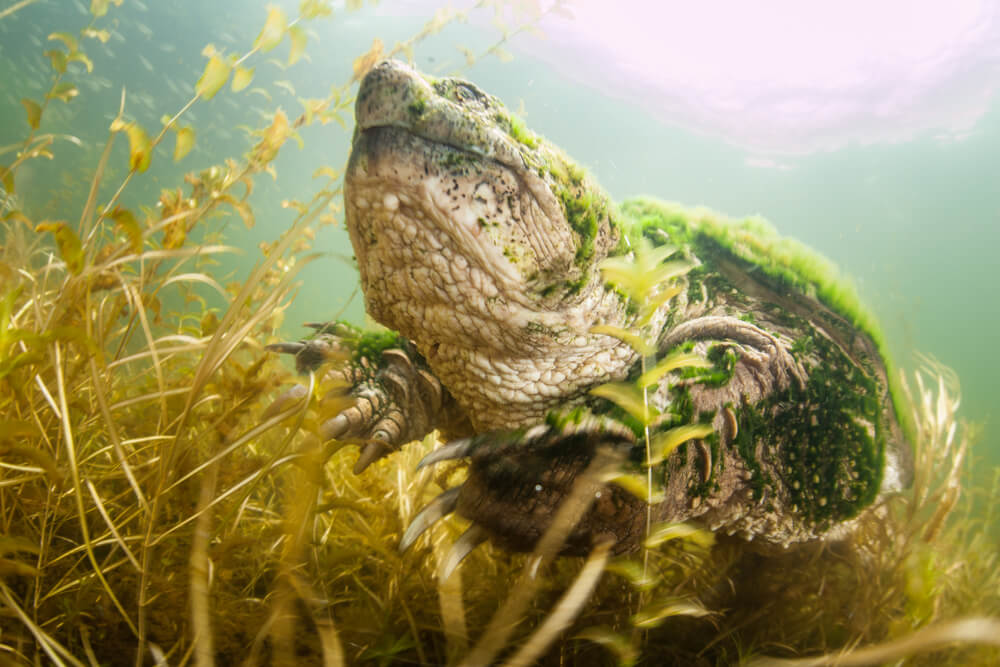
My investigation into the snapping turtle’s bite force shows that these reptiles possess powerful jaws. In fact, their bite force is quite remarkable when compared to other animals.
Let’s dive into some numbers to get a clearer understanding of their jaw strength.
The common snapping turtle (Chelydra serpentina) has a bite force of around 209 pounds per square inch (psi). This demonstrates how, despite their smaller size compared to alligator snapping turtles, they still possess a substantial ability to apply pressure.
On the other hand, the alligator snapping turtle (Macrochelys temminckii) boasts an impressive bite force of up to 1,000 psi, putting it in the realm of some of the most powerful biters in the animal kingdom.
To put this into perspective, the human bite force is around 162 psi, which is significantly less than even the common snapping turtle.
Here are some bite force numbers for comparison:
- Common snapping turtle bite force: 209 psi
- Alligator snapping turtle bite force: 1,000 psi
- Human bite force: 162 psi
With such a high bite force, a snapping turtle can easily cut through materials like rope with minimal effort. The pressure exerted by their jaws is more than enough to cause serious injury to anything caught within their grasp.
It’s important to note that the snapping turtle’s jaw force is not only about strength but also speed. These turtles are known to snap their jaws shut rapidly, making it difficult for prey to escape once they are within reach.
In summary, the snapping turtle’s bite force is quite remarkable, with both the common and alligator snapping turtle variants displaying powerful jaw strength.
Understanding these numbers highlights the incredible force they can apply with their jaws in comparison to other species like humans.
Comparison of Snapping Turtle’s Bite Force with Other Animals
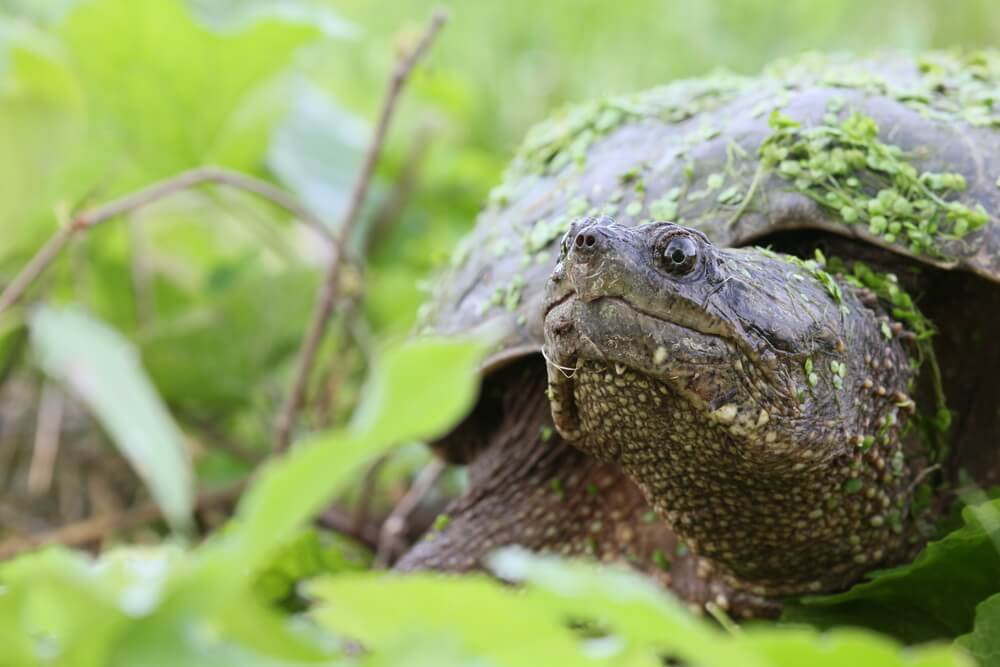
As an individual who has spent considerable time studying wildlife, I can attest to the impressive power of a snapping turtle’s bite. Nevertheless, it is important to put this strength into perspective by drawing comparisons with other animals known for their biting prowess.
In this section, I will provide a brief analysis of the snapping turtle’s bite force relative to a range of other formidable biters for context.
Firstly, let’s consider the alligator, a well-known predator famed for its jaw strength. The bite force of an American alligator measures around 2,125 pounds per square inch (PSI), while an adult snapping turtle can exhibit a bite force of about 208 PSI.
Though impressive, the snapping turtle’s bite pales in comparison to this mighty reptile.
When looking at other aquatic creatures, such as fish, snapping turtles hold their own fairly well. For instance, the king salmon, which reaches sizes almost two-thirds that of a snapping turtle, is known for its ability to catch and kill prey with forceful bites.
Its bite force is relatively less threatening, ranging from 30 to 50 PSI.
Moving into the mammalian kingdom, the bite force of a jaguar reaches around 1,500 PSI, far surpassing the snapping turtle. Bengal tigers and polar bears also boast powerful bites, exhibiting forces of approximately 1,050 PSI and 1,200 PSI, respectively.
Against these land-dwelling giants, it becomes clear that the snapping turtle is far from the most powerful biter among animals.
On the other hand, the hyena possesses a bite force of around 1,100 PSI, which, while surpassing the snapping turtle, is a bit weaker in comparison to other mammalian predators.
Among reptiles, the most formidable bite comes from the saltwater crocodile, which boasts a staggering 3,700 PSI.
In the world of deadly bites, great white sharks and bull sharks lead the way, with bite forces measuring around 4,000 PSI and 1,300 PSI, respectively.
Among semi-aquatic animals, the hippopotamus has a bite force of around 1,800 PSI.
From this analysis, it is clear that the snapping turtle’s bite force is indeed remarkable, especially considering their smaller size relative to other animals.
Yet, it is also evident that numerous species of predators, from the alligator to the great white shark, boast stronger bites.
In spite of its relatively modest bite force, the snapping turtle still manages to secure meals through a combination of speed, stealth, and ambush tactics, allowing it to prey on fish effectively.
Nonetheless, my experience has taught me to approach these creatures with caution, as their bites can do considerable damage, and the risk of salmonella infection only adds to the hazards they pose.
Damage Caused by Snapping Turtle’s Bite
As someone who has researched and studied snapping turtles, I can confidently say that their bite can cause significant injuries. Snapping turtles have a strong bite force which can inflict serious damage to humans and other animals.
Their powerful jaws are capable of breaking bones, so it’s essential to handle them with utmost caution.
Fingers, in particular, can be at high risk when dealing with snapping turtles. One misplaced hand can result in a crushed finger and possibly even amputation in extreme cases.
While their bite force varies depending on the species and size of the turtle, even smaller turtles can cause serious injuries. Bleeding is likely to accompany any bite from a snapping turtle, so it’s important to have proper medical care accessible when handling these creatures.
In addition to the crushing and shearing damage inflicted by their jaw and sharp beak, snapping turtles may also transmit bacteria through their saliva. This can lead to infections, making the injury even more critical and necessitating prompt medical attention.
To minimize the risk of injury, I recommend:
- Using appropriate tools, such as tongs, when handling snapping turtles
- Wearing protective gloves
- Keeping fingers and other vulnerable body parts away from the turtle’s mouth
A snapping turtle’s bite is a force to be reckoned with, and it’s crucial to exercise caution when coming into contact with these fascinating reptiles.
Their powerful jaws can cause considerable damage, including broken bones and severe lacerations, which may lead to serious injuries and infections.
Medical Attention After a Snapping Turtle Bite
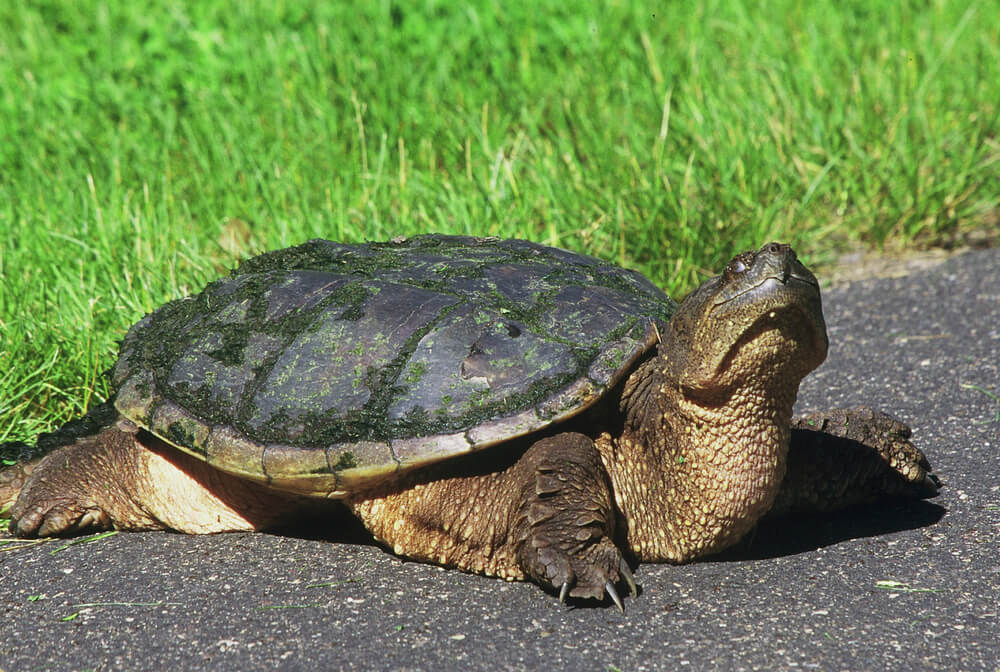
I know that a snapping turtle bite can be severe and may require medical attention. As soon as I am bitten, I ensure to wash the area thoroughly with soap and water to help reduce the risk of infection.
Bacteria and viruses from the turtle’s mouth could potentially infect the wound site.
One thing that is crucial for me to do after being bitten is to closely monitor the wound for signs of infection. Some common symptoms of infected wounds include redness, swelling, warmth, and pus discharge.
I always watch out for any changes in the color, smell, or size of the wound.
In the case of a severe bite, I recognize the importance of seeking medical attention immediately. Medical professionals can properly clean and treat the wound and, if necessary, provide antibiotics to fight against infection.
They can also stitch the wound if needed and administer a tetanus shot, as turtles can harbor tetanus bacteria.
I understand the potential risks and complications that can arise from a snapping turtle bite. Taking the necessary precautions and actions can help me ensure a faster and safer recovery.
Snapping Turtles as Pets
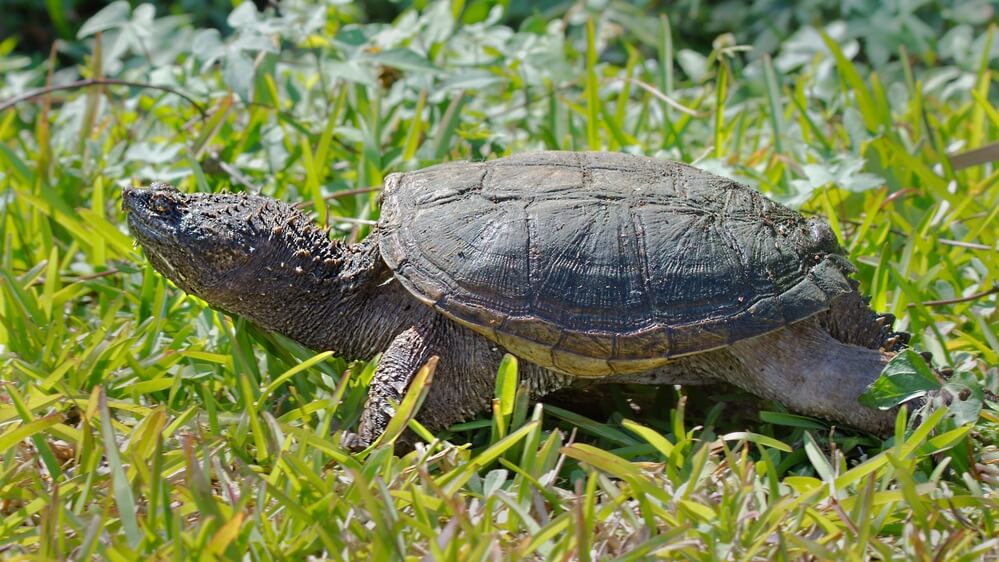
As a snapping turtle enthusiast, I can certainly understand the appeal of having one as a pet. They are fascinating creatures with unique characteristics. Regardless, it is important to approach the idea of keeping snapping turtles as pets with respect and knowledge.
In my experience, handling snapping turtles can be risky due to their powerful and painful bite. One must be extremely cautious when handling them, as a bite from a snapping turtle can result in severe injury and a high risk of infection.
Therefore, I advise new owners to learn proper handling techniques and avoid unnecessary interaction with their pet turtles.
When housing snapping turtles, I have found that they require a proper habitat with ample space, clean water, and hiding spots. Additionally, I recommend providing live bait such as fish, insects, and even small mammals, as this most closely replicates their natural diet.
It is important to remember that snapping turtles are not domesticated animals and should not be treated as such. As a pet owner, I have made it my responsibility to learn as much as possible about these reptiles in order to give them the best possible care.
With proper understanding, respect, and care, snapping turtles can make for interesting and unique pets.
Frequently Asked Questions
Can a snapping turtle’s bite be fatal?
It depends on the circumstances. While a snapping turtle’s bite can be very painful and cause severe injuries, it’s generally not fatal to humans. However, if left untreated, deep wounds may lead to infections or complications that could become life-threatening.
How does a snapping turtle’s bite force compare to other animals?
A snapping turtle’s bite force is relatively strong when compared to some animals but not as strong as others. For example, the common snapping turtle has a bite force of around 208 newtons, which is more than a human’s but significantly less than animals like crocodiles or hyenas.
What is the maximum size of a snapping turtle?
Snapping turtles can grow quite large, with the alligator snapping turtle being the largest species in North America.
Adult alligator snapping turtles can reach lengths of up to 30 inches and weigh over 200 pounds, while common snapping turtles are generally smaller, with a maximum size of around 20 inches and 40 pounds.
Are snapping turtles a threat to pets like dogs?
Yes, snapping turtles can pose a threat to pets, especially if the pet is curious or tries to interact with the turtle. It’s important for pet owners to keep their animals away from bodies of water where snapping turtles may live and to be cautious when walking their pets near these areas.
Can a snapping turtle’s bite cause broken fingers or bones?
A snapping turtle’s bite can be strong enough to break fingers or small bones, particularly in the case of larger turtles. That’s why it’s crucial to avoid handling snapping turtles and to back away slowly if you encounter one.
Professionals who need to handle snapping turtles often use specialized tools to avoid getting bitten.
What factors contribute to the strength of a snapping turtle’s bite?
There are several factors that contribute to a snapping turtle’s bite strength. These include the turtle’s size, jaw structure, and muscle mass. Additionally, the turtle’s diet and overall health can influence the power of its bite.

